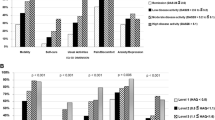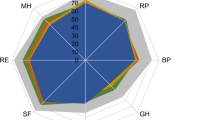Abstract
The aims of this study were to assess the health-related quality of life (HRQoL) in patients with self-reported rheumatic diseases (RD), to classify self-reported rheumatic patients in groups according to their health state and to explore the associations between health status and sociodemographic variables. Data came from the Portuguese Epidemiologic study of the RD. A sample of the Portuguese population aged 18 or more (n = 10,661) stratified by region and locality dimension was interviewed by trained interviewers and answered a standardized questionnaire that included the SF-36v1, the EQ-5D-3L, medical history, identification of potential rheumatic diseases, sociodemographic characteristics, among others. Descriptive statistics and parametric tests were used to compare HRQoL of respondents with and without RD. Comparisons with normative data from the Portuguese population were also carried out. A cluster analysis was used to classify respondents into homogeneous groups. Regression analyses were used to identify factors associated with HRQoL. Respondents with self-reported RD assigned a lower self-perception to their health status. The burden of disease was observed mainly in physical function, role physical and bodily pain. The EQ-5D-3L dimensions show similar results: the intensity of problems is significantly more evident in respondents with self-reported RD. HRQoL of respondents with self-reported RD is related to sociodemographic variables and is significantly lower when compared with the Portuguese population. Four clusters of homogeneous respondents with self-reported RD were formed and characterized according to a number of variables. Factors associated with HRQoL were identified. In conclusion, suffering from a self-reported RD has a significant impact on self-perceived health status and on the quality of life.
Similar content being viewed by others
References
Devlin N, Appleby J (2010) Getting the most out of proms-putting health outcomes at the heart of NHS decision-making. The King’s Fund and Office of Health Economics, London
Badley EM, Rasooly I, Webster GK (1994) Relative importance of musculoskeletal disorders as a cause of chronic health problems, disability, and health care utilization: findings from the 1990 Ontario Health Survey. J Rheumatol 21(3):505–514
Yelin E, Callahan LF (1995) The economic cost and social and psychological impact of musculoskeletal conditions. National Arthritis Data Work Groups. Arthritis Rheum 38(10):1351–1362
Makela M, Heliovaara M, Sievers K, Knekt P, Maatela J, Aromaa A (1993) Musculoskeletal disorders as determinants of disability in Finns aged 30 years or more. J Clin Epidemiol 46(6):549–559
Chorus A, Miedema H, Boonen A, Linden SVD (2003) Quality of life and work in patients with rheumatoid arthritis and ankylosing spondylitis of working age. Ann Rheum Dis 62:1178–1184
Currey S, Rao J, Whnfield J, Callahan L (2003) Performance of a generic health-related quality of life measure in a clinic population with rheumatic disease. Arthritis and rheumatism. Arthritis Care Res 49(5):658–664
Kosinski M, Kujawski S, Martin R, Wanke L, Buatti M, Ware J et al (2002) Health-related quality of life in early rheumatoid arthritis: impact of disease and treatment response. Am J Manag Care 8(3):231–240
Picavet H, Hoeymans N (2004) Health related quality of life in multiple musculoskeletal diseases: SF-36 and EQ-5D in the DMC3 study. Ann Rheum Dis 63(6):723–729
Salaffi F, Carotti M, Gasparini S, Intorcia M, Grassi W (2009) The health-related quality of life in rheumatoid arthritis, ankylosing spondylitis, and psoriatic arthritis: a comparison with a selected sample of healthy people. Health Qual Life Outcomes 7:25. doi:10.1186/1477-7525-7-25
Senra H, Rogers H, Leibach G, Altamar M, Plaza S, Perrin P et al (2014) Health-related quality of life and depression in a sample of Latin American adults with rheumatoid arthritis. Int J Rheum Dis. doi:10.1111/1756-185X.12412
Whalley D, McKenna S, Jong Z, Heijde D (1997) Quality of life in rheumatoid arthritis. Br J Rheumatol 36:884–888
Moorthy L, Roy E, Kurra V, Peterson M, Hassett A, Lehman T et al (2014) Health related quality of life measure in systemic pediatric rheumatic diseases and its translation to different languages: an international collaboration. Pediatr Rheumatol 12:49
Brasil T, Ferriani V, Machado C (2003) Health related quality of life survey about children and adolescents with juvenile idiopathic arthritis. Jornal de Pediatria 79(1):63–68 (article in Portuguese)
Ferreira L, Ferreira P, Baleiro R (2008) Quality of life in patients with rheumatoid arthritis. Acta Reumatológica Portuguesa 33(3):341–342 (article in Portuguese)
Ferreira L, Ferreira P, Pereira L (2014) Comparing the performance of the SF-6D and the EQ-5D in different patient groups. Acta Médica Portuguesa 27(2):236–245
Oliveira P, Monteiro P, Coutinho M, Salvador MJ, Costa ME, Malcata A (2009) Health-related quality of life and chronic pain experience in rheumatic diseases. Acta Reumatológica Portuguesa 34(3):511–519 (article in Portuguese)
Ramiro S, Canhão H, Branco JC (2010) EpiReumaPt—Portuguese epidemiologic study of the rheumatic diseases. Acta Médica Portuguesa 35:384–390
Rodrigues AM, Gouveia N, Costa LP, Eusébio M, Ramiro S, Machado P et al (2015) EpiReumaPt—the study of rheumatic and musculoskeletal diseases in Portugal: a detailed view of the methodology. Acta Reumatológica Portuguesa 40:110–124
Branco J, Rodrigues AM, Gouveia N, Eusébio M, Ramiro S, Machado PM, et al. (2016) Prevalence and physical and mental health patterns of rheumatic and musculoskeletal diseases in Portugal: results from EpiReumaPt, a national health survey. RMD open 2(1):e000166
Gouveia N, Rodrigues A, Ramiro S, Machado P, Costa L, Mourão A et al (2015) EpiReumaPt: how to perform a national population based study—a practical guide. Acta Reumatológica Portuguesa 40:128–136
Gouveia N, Rodrigues A, Eusébio M, Ramiro S, Machado P, Canhão H et al (2016) Prevalence and social burden of active chronic low back pain in the adult Portuguese population: results from a national survey. Rheumatol Int 36(2):183–197
Ware J, Sherbourne C (1992) The MOS 36-item short-form health survey (SF-36). Conceptual framework and item selection. Med Care 30:473–483
Ware J, Snow K, Kosinski M, Gandek B (1993) SF-36 Health survey manual and interpretation guide. The Health Institute, Boston
Ware JE, Kosinski M, Keller SD (1994) SF-36 physical and mental health summary scales: a user’s manual. The Health Institute, Boston
Ware J, Kosinski M, Dewey J (2000) How to score version two of the SF-36 health survey. QualityMetric, Incorporated, Rhode Island
Ferreira P (2000) Creation of the Portuguese version of the MOS SF-36. Part I—Linguistic and cultural adaptation. Acta Médica Portuguesa 13:55–66 (article in Portuguese)
Ferreira P (2000) Creation of the Portuguese version of MOS SF-36. Part II—validation tests. Acta Médica Portuguesa 13(3):119–127 (article in Portuguese)
Hawthorne G, Osborne R, Taylor A, Sansoni J (2007) The SF36 version 2: critical analyses of population weights, scoring algorithms and population norms. Qual Life Res 16:661–673
Norman R, Church J, van den Berg J, Goodall S (2013) Australian health-related quality of life population norms derived from the SF-6D. Aust N Z J Public Health 37(1):17–23
Ferreira P, Santana P (2003) Health status perception and quality of life in the working population: towards a definition of normative data. Revista Portuguesa de Saúde Pública 21(2):15–30 (article in Portuguese)
Brooks R (1996) EuroQol: the current state of play. Health Policy 37:53–72
Dolan P (1997) Modelling valuations for EuroQol health states. Med Care 35:1095–1108
Ferreira L, Ferreira P, Pereira L, Oppe M (2014) The valuation of the EQ-5D in Portugal. Qual Life Res 23(2):413–423. doi:10.1007/s11136-013-0448-z
Ferreira P, Ferreira L, Pereira L (2013) Contribution for the validation of the Portuguese version of the EQ-5D. Acta Médica Portuguesa 26(6):664–675
Luo N, Johnson J, Shaw J, Feeny D, Coons S (2005) Self-reported health status of the general adult U.S. Population as assessed by the EQ-5D and health utilities index. Med Care 43(11):1078–1086
Sun S, Chen J, Johannesson M, Kind P, Xu L, Zhang Y et al (2011) Population health status in China: EQ-5D results, by age, sex and socio-economic status, from the National Health Services Survey 2008. Qual Life Res 20(3):309–320
Szende A, Williams A (eds) (2004) Measuring self-reported population health: an international perspective based on EQ-5D. SpringMed Publishing, Hungary
Ferreira LN, Ferreira PL, Pereira LN, Oppe M (2014) EQ-5D Portuguese population norms. Qual Life Res 23(2):425–430. doi:10.1007/s11136-013-0488-4
Ferreira P, Ferreira L, Pereira L (2015) SF-6D portuguese population norms. Eur J Health Econ 16(3):235–241. doi:10.1007/s10198-014-0568-6
Portuguese Statistical Office (2012) Census 2011 resultados definitivos—Portugal. INE, Lisbon
Snyder C, Aaronson N, Choucair A, Elliott T, Greenhalgh J, Halyard M et al (2012) Implementing patient-reported outcomes assessment in clinical practice: a review of the options and considerations. Qual Life Res 21(8):1305–1314. doi:10.1007/s11136-011-0054-x
West E, Jonsson S (2005) Health-related quality of life in rheumatoid arthritis in Northern Sweden: a comparison between patients with early RA, patients with medium-term disease and controls, using SF-36. Clin Rheumatol 24:117–122
Bharmal M, Thomas J (2006) Comparing the EQ-5D and the SF-6D descriptive systems to assess their ceiling effects in the US general population. Value in Health 9(4):262–271
Cunillera O, Tresserras R, Rajmil L, Vilagut G, Brugulat P, Herdman M et al (2010) Discriminative capacity of the EQ-5D, SF-6D, and SF-12 as measures of health status in population health survey. Qual Life Res 19(6):853–864
Ferreira L, Brito U, Ferreira P (2010) Quality of life in asthma patients. Portuguese J Pulmonol XVI(1):23–55
Fortin M, Dubois M-F, Hudon C, Soubhi H, Almirall J (2007) Multimorbidity and quality of life: a closer look. Health Qual Life Outcomes 5:52
Krishnan E, Häkkinen A, Sokka T, Hannonen P (2005) Impact of age and comorbidities on the criteria for remission and response in rheumatoid arthritis. Ann Rheum Dis 64:1350–1352
Wolfe F, Michaud K, Li T, Katz R (2010) Chronic Conditions and health problems in rheumatic diseases: comparisons with rheumatoid arthritis, noninflammatory rheumatic disorders, systemic lupus erythematosus, and fibromyalgia. J Rheumatol 37:2. doi:10.3899/jrheum.090781
Acknowledgements
This paper was financed by National Funds provided by FCT- Foundation for Science and Technology [grant numbers UID/Multi/04066/2013 and UID/SOC/04020/2013].
Funding
The data used here came from the EpiReumaPt study, which was endorsed by the Alto Patrocínio da Presidência da República and was supported by a Grant from Directorate-General of Health. The EpireumaPt study was also sponsored by: Fundação Calouste Gulbenkian, Fundação Champalimaud, Fundação AstraZeneca, Abbvie, Merck Sharp and Dohme, Pfizer, Roche, Servier, Bial, D3A Medical Systems, Happybrands, Centro de Medicina Laboratorial Germano de Sousa, Clínica Médica da Praia da Vitória, CAL-Clínica, Galp Energia, Açoreana Seguros and individual support of rheumatologists.
Author information
Authors and Affiliations
Corresponding author
Ethics declarations
Conflict of interest
None.
Ethical approval
All procedures performed in studies involving human participants were in accordance with the ethical standards of the institutional and/or national research committee and with the 1964 Helsinki declaration and its later amendments or comparable ethical standards.
Informed consent
Informed consent was obtained from all individual participants included in the study.
Rights and permissions
About this article
Cite this article
Ferreira, P.L., Gonçalves, S.P., Ferreira, L.N. et al. Assessing quality of life of self-reported rheumatic patients. Rheumatol Int 36, 1265–1274 (2016). https://doi.org/10.1007/s00296-016-3517-0
Received:
Accepted:
Published:
Issue Date:
DOI: https://doi.org/10.1007/s00296-016-3517-0







